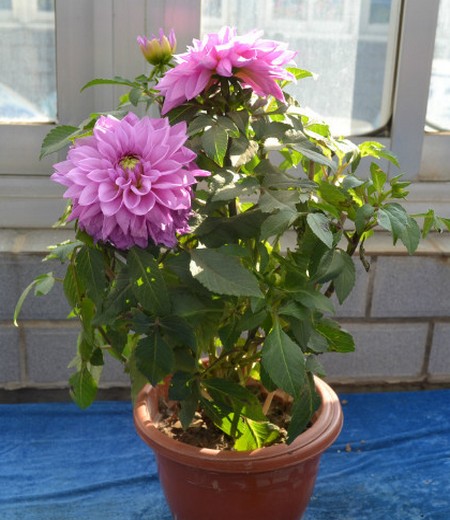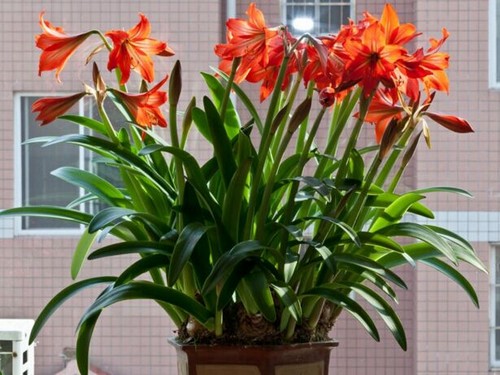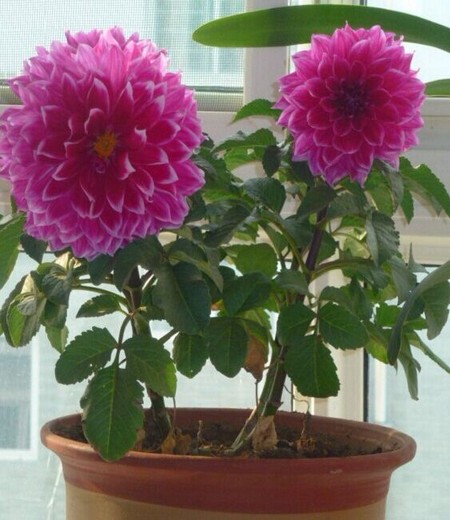Culture methods and matters needing attention of Dahlia
Dahlia is native to Mexico. Mexicans regard it as a symbol of generosity and richness, so they respect it as the national flower. At present, it is planted in most countries in the world, and new varieties are selected from time to time. According to statistics, there are more than 30,000 dahlia varieties, which is one of the species with the largest number of flower varieties in the world. Dahlia is one of the most famous flowers in the world. Then let's take a look at the breeding methods and points for attention of dahlias.

Potted soil:
Dahlia is suitable for sandy loam which is loose, rich in humus and good drainage. Potted dahlia planting soil is generally suitable for vegetable garden soil (50%), rotten leaf soil (20%), sandy soil (20%) and dried dung (10%). The consolidated soil is easy to cause waterlogging and rotting roots, which can not be used. In the daily management, loosen the soil in time, remove the waterlogging in the basin, the fleshy root of Dahlia has too much water content in the soil, which will cause poor air permeability and rot at that time.
Lighting:
Dahlias like light, if placed in shade for a long time, it will grow poorly, resulting in weak roots, thin leaves and thin stems, light flowers, and even some can not blossom. Therefore, potted dahlias should be placed in a sunny place with more than 6 hours of light a day, so that the plants are strong and the flowers are large and plump. If the sunshine is less than 4 hours a day, the branching of stems and leaves and the formation of buds will be affected to a certain extent, especially if there is little sunshine, the flowering is not smooth, the growth of stems and leaves is poor, and it is easy to get sick.
Watering:
The amount of water can control the height of Dahlia plants. Its moisture should be controlled in the seedling stage to promote its dwarfing. In summer, in order to reduce the temperature, increase the air humidity and reduce the water evaporation of the stems and leaves of Dahlia, water should be sprayed once or twice a day. Watering once at 3: 00 to 4 p.m., the amount of water should not be too large.
Plastic surgery:
The pruning of potted dahlias should be flexibly controlled according to the variety. In general, single-plant plastic surgery is used for large varieties and 4-book plastic surgery for medium-sized varieties. Single plant plastic surgery is to retain the terminal bud, remove all the bowels, so that nutrition is concentrated, forming a low plant, large flower type of single plant Dahlia.
Inserting pole supporting plant
The stem of Dahlia is empty and brittle, and it is easy to be broken by the wind. It is necessary to support bamboo planting in time, which can also avoid the bending of branches and improve the ornamental value of potted plants. When the plant is more than 30 cm tall, a small bamboo should be inserted next to each branch and tied with hemp skin (or string); as the plant grows taller and taller, a longer bamboo should be replaced in time, and the final bamboo should be placed on the lower part of the bud.
Plant overwintering
The roots of Dahlia can not be frozen. In November, after the branches and leaves have withered, the aboveground parts should be cut off, moved indoors and preserved in the original pot. The root tuber can also be taken out and hung for 1-2 days and buried in indoor moist sand with a temperature of no more than 5 degrees, and then planted in the pot the following spring.
Note:
1. Dahlias are positive flowers, and it takes at least 4 or 5 hours of direct light every day to grow leaves and flowers, which should be placed in the roof garden, south and west balcony, and the balcony should be rotated 180 °for about 10 days to prevent the crown. Avoid indoor and shady places where the sun is not exposed.
2. Dahlia can adapt between 10 ℃ and 32 ℃, and 15 ℃ to 25 ℃ is the most suitable, and the growth is stagnant above 32 ℃, which can be placed on the cool east and north balcony. In the hot and rainy summer, dahlias placed in the roof garden should be shaded and protected from rain and rotting roots. Dahlia is not resistant to cold, its underground stem will wither after frost, and the underground root will be dormant. The south of the Yangtze River can overwinter outdoors, and the north of the Yangtze River should be moved to the low temperature of 1 ℃ to 10 ℃ to overwinter.
3. It likes a cool environment with good ventilation, poor ventilation, weak stems and brittle stems due to hollow stems in strong wind, so it is easy to lodge and break. Generally grow to 30 cm, with 4 such as pinkie thick bamboo pole or chopsticks thick steel bar, inserted around the basin, unearthed about 50 cm, with plastic aluminum, copper wire to do 2 or 3 circles, connect the four small columns to prevent plant lodging.
4. Dahlias grow best in sandy loam. 50% rotten leaf soil, 35% vegetable garden soil, 10% sand and 5% plant ash are mixed into loose and fertile neutral sandy loam. Every year, the pot is turned into a new soil in early spring, otherwise it is easy to degenerate and the flowers are light. The roots of heavy clay are easy to rot and grow poorly.
5, Dahlia plant height 30 cm to 200 cm, there are high, medium and low three grades, balcony pot should choose 30 cm to 60 cm dwarf varieties, too high both block the light, and easy to lodge in case of strong wind, or even fall down in the pot, injury and smashing accidents may occur.
6. It likes the humid environment, the leaves are easy to shrink and turn yellow during drought, watering should be moderate, the soil is slightly moist, too wet is easy to grow, and waterlogging is easy to rot roots, so it is appropriate to put broken hard plastic foam blocks at the bottom of the basin when planting to enhance air permeability and drainage to prevent rotting roots. At the same time of proper water control, we should often spray water to the leaf surface to increase air humidity and facilitate its growth.
7. It likes fertilizer, and some bone meal can be added to the soil when it is put on the basin. During the growing period, the thin fertilizer is applied frequently for 7 to 10 days, preferably with potassium dihydrogen phosphate solution, with a concentration of 0.1% at seedling stage, 0.2% at flowering stage, or 5% calcium superphosphate. Raw and thick fertilizer is easy to burn roots, nitrogen fertilizer alone is easy to grow, and the stem is soft and lodging.
Time: 2019-06-01 Click:
- Prev

How to raise potted Zhu Dinghong
Zhu Dinghong culture method is simple, in most cases casually buried in the soil can flourish, and even the light ball forgotten in the corner can tenaciously blossom. There are many varieties of Zhu Dinghong, which is not inferior to tulips. Zhu Dinghong likes a warm and humid climate, and the suitable temperature for growth is 18-25 degrees Celsius.
- Next

How do potted dahlias grow? Dahlia planting method
The key to the growth of potted dahlia lies in strengthening the management of pot soil, giving sufficient light, applying water and fertilizer frequently, and timely shaping and pruning. Dahlia is one of the most diverse species of flowers in the world, a symbol of blessing
Related
- Fuxing push coffee new agricultural production and marketing class: lack of small-scale processing plants
- Jujube rice field leisure farm deep ploughing Yilan for five years to create a space for organic food and play
- Nongyu Farm-A trial of organic papaya for brave women with advanced technology
- Four points for attention in the prevention and control of diseases and insect pests of edible fungi
- How to add nutrient solution to Edible Fungi
- Is there any good way to control edible fungus mites?
- Open Inoculation Technology of Edible Fungi
- Is there any clever way to use fertilizer for edible fungus in winter?
- What agents are used to kill the pathogens of edible fungi in the mushroom shed?
- Rapid drying of Edible Fungi

